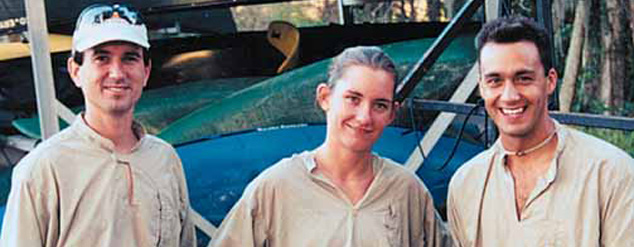
Florida waters are home to manatees. These ponderous-looking sea mammals, also known as sea cows, communicate with each other through a series of squeaks, squeals, and screams. The attachment between mother and calf is strong. When playing, manatees nuzzle and nibble each other, sometimes even embracing with their flippers. These peaceful creatures have no natural enemies, but are quite vulnerable to reckless powerboaters. What they don't have going for them is good P.R. Unlike dolphins which flaunt Sea World glam-status, the much maligned manatees are a maritime version of Rodney Dangerfield ? they just don't get any respect. To find out more about these misunderstood mammals, RailRiders talked with marine biologist Kerri Scolardi, who spent two years studying manatees at the Mote Marine Laboratory in Sarasota, Florida, and is now pursuing a graduate degree. Kerri's other pursuits include a black belt in karate, roller hockey, adventure racing, with her husband Jamie and local friends, and a recent seven-week stint on a marine research vessel stationed off the Antarctic coast.
Q: Compare manatees to dolphins.
Kerri Scolardi: Manatees aren't less charismatic than dolphins, as I have met many manatees with plenty of personality. But dolphins are lighter, faster and flashier. Plus, the average manatee weighs about 1,500 pounds. I'd like to see a trainer at Sea World get an animal that big to jump through a hoop. Dolphins are carnivores, and rely upon their speed and maneuverability to catch prey, whereas manatees feed mostly on sea grass, which is how they got their nickname "sea cow." The mouths of dolphins are naturally and permanently curved upward in what some people perceive as a smile. Manatees are related to elephants, but they aren't exactly the most handsome creatures, and their propensity for flatulence doesn't help their cause much either.
Q: Then, manatees don't make good house pets? Are they trainable?
KS: Since manatees are endangered mammals, and just feeding one a piece of lettuce will land you a nice hefty fine, taking one home to play in your pool would probably land you in jail. So no, they do not make good house pets. Not to mention they would eat you out of house and home, since they consume fifteen percent of their body weight daily. But yes, they are trainable. We had two captured manatees at the marine lab, and they would respond to whistles and come to a certain spot in the tank and to float upside-down while the veterinarian took blood from their pectoral flipper. Manatees don't bite, so conceivably you can swim with them, and at some warm-water refuges, many people do swim with them.
However, I don't recommend it. Manatees have extremely powerful tails, and if spooked, they could really whack someone senseless with them.
Q: Have you had any encounters with sharks?
KS: The only sharks I have encountered while diving are nurse and lemon sharks, which are basically harmless and usually just sit there and stare. I am more afraid of barraccudas. The scariest encounter I have ever had with a creature from the deep was with a very large Moray eel that decided he didn't like being stared at and came at me and my partner, catching us both off guard. I have never heard a grown man scream like that ? and it was underwater, so that tells you how loud he was.
Q: What got you interested in marine biology?
KS: Jacques Cousteau had nothing to do with it. I was born and raised in Sarasota, which is known for its beautiful beaches. Since I was in diapers, I spent almost all my free-time running around on the beach digging up coquina shells or swimming around until my eyes shriveled up from being in the salt water.
Q: Describe diving off Antarctica.
KS: The research cruise was stationed off the northwestern side of the Antarctic peninsula. There were 30 scientists from different oceanographic institutions studying everything from plankton and fish to birds and whales. I was part of the krill research team. The krill in the Antarctic are basically eaten by everything larger than they are, and are an extremely important part of the food chain. Part of my job involved doing growth and metabolism experiments. I was the only woman diver on this cruise. The divemaster for our cruise told me that you basically spend your first five dives down there trying to stay alive. He was right. But I can't begin to describe how beautiful and pristine the water is down there. On my second dive, I was accompanied by a very curious crabeater seal, and when I surfaced I was greeted by a large emperor penguin hanging out by our Zodiac.
Q: What is your opinion of RailRiders?
KS: Being an adventure racer, I have a nice collection of RailRiders attire. Racing in Florida can be extremely hot, and I used to hate wearing anything but the bare minimum while racing to stay cool. Now I train in RailRiders, even during the hottest summer days. Not only does it keep me cool, but it keeps me from getting a sunburn, something I am very wary about in my older and wiser years. RailRiders clothing are also made very well. I still have my original RailRiders Eco-Mesh shirt from three years ago, and after numerous races and washing machine cycles, it is amazingly in good shape ? better shape than I am in probably.

